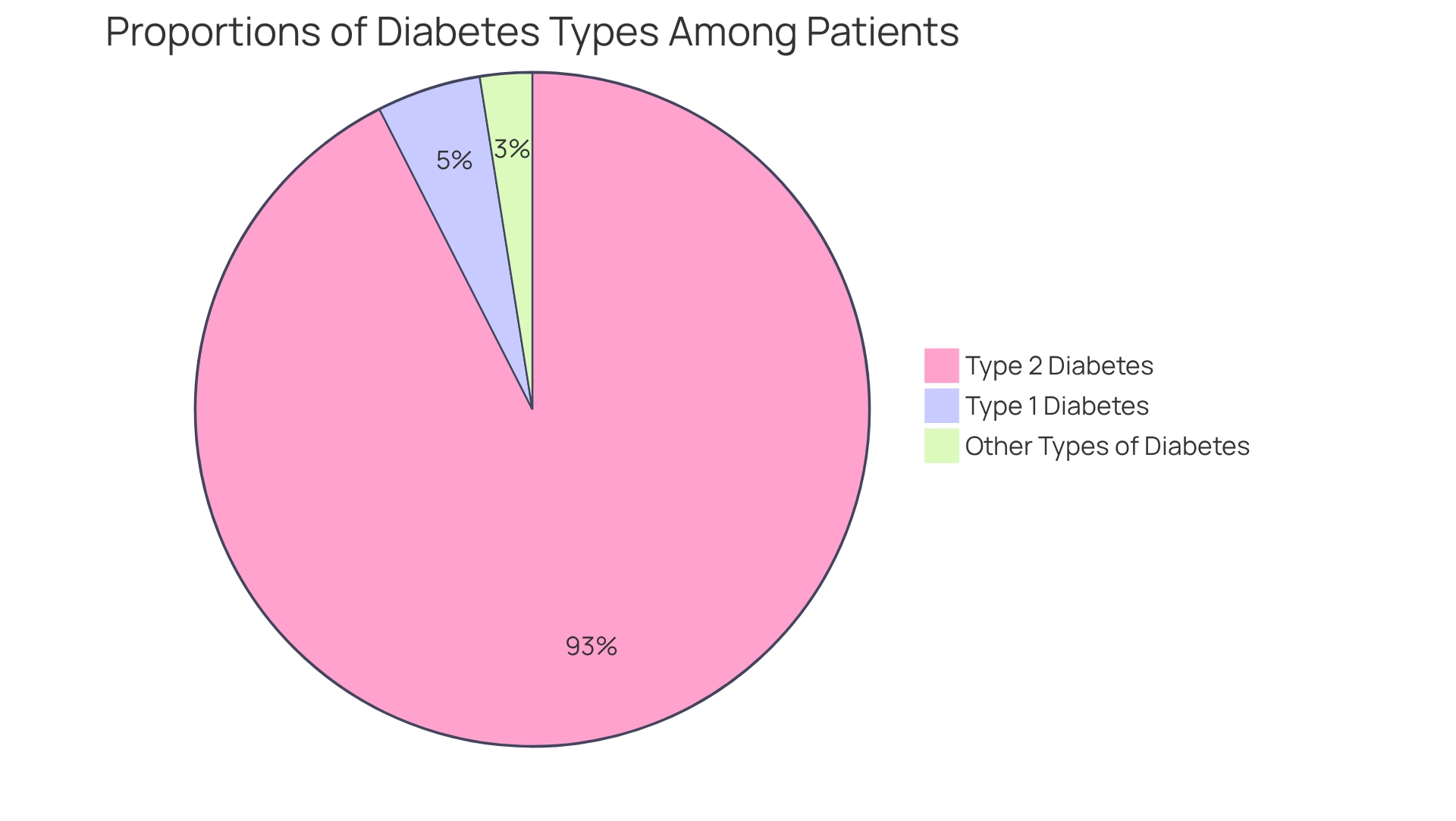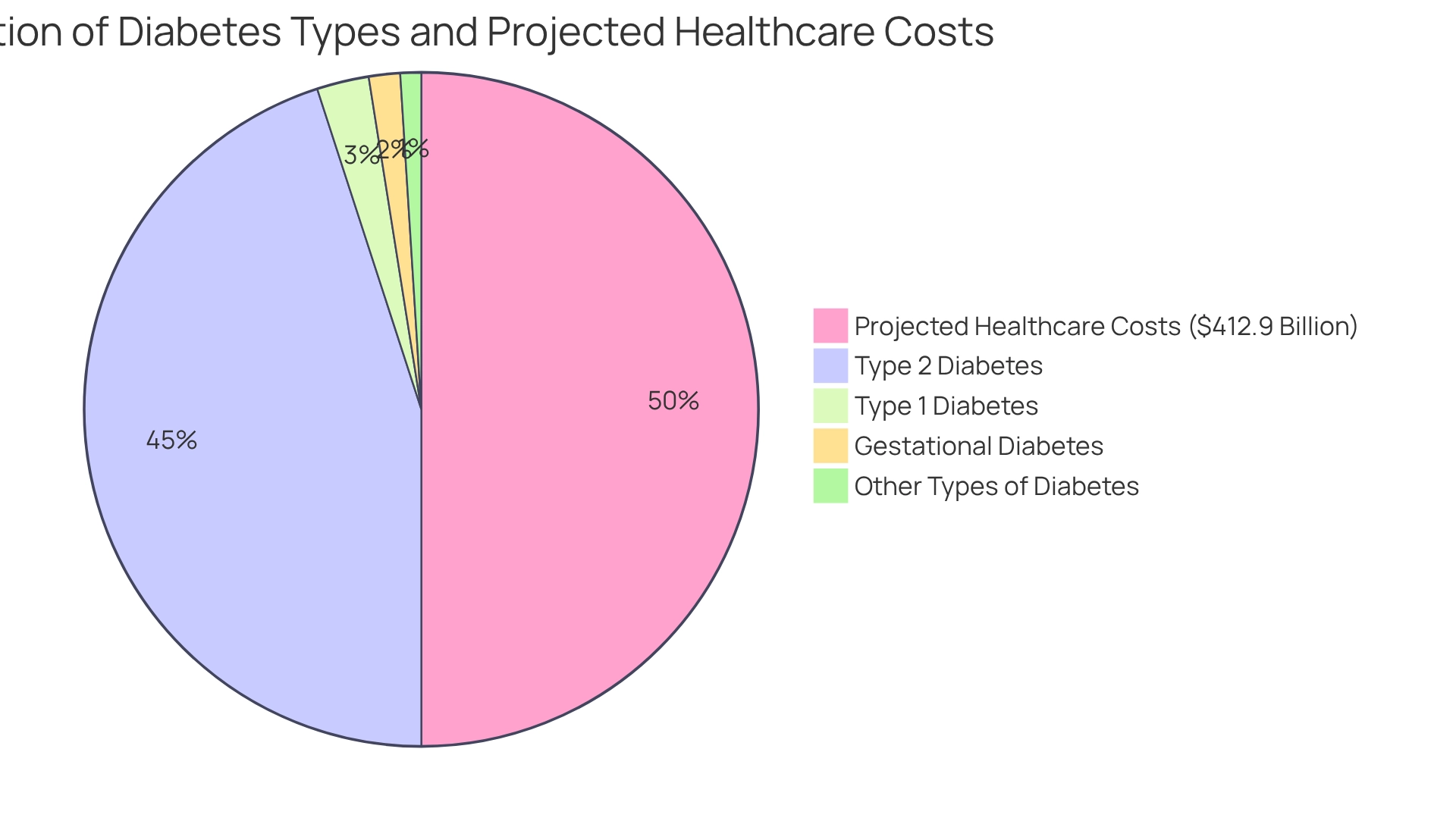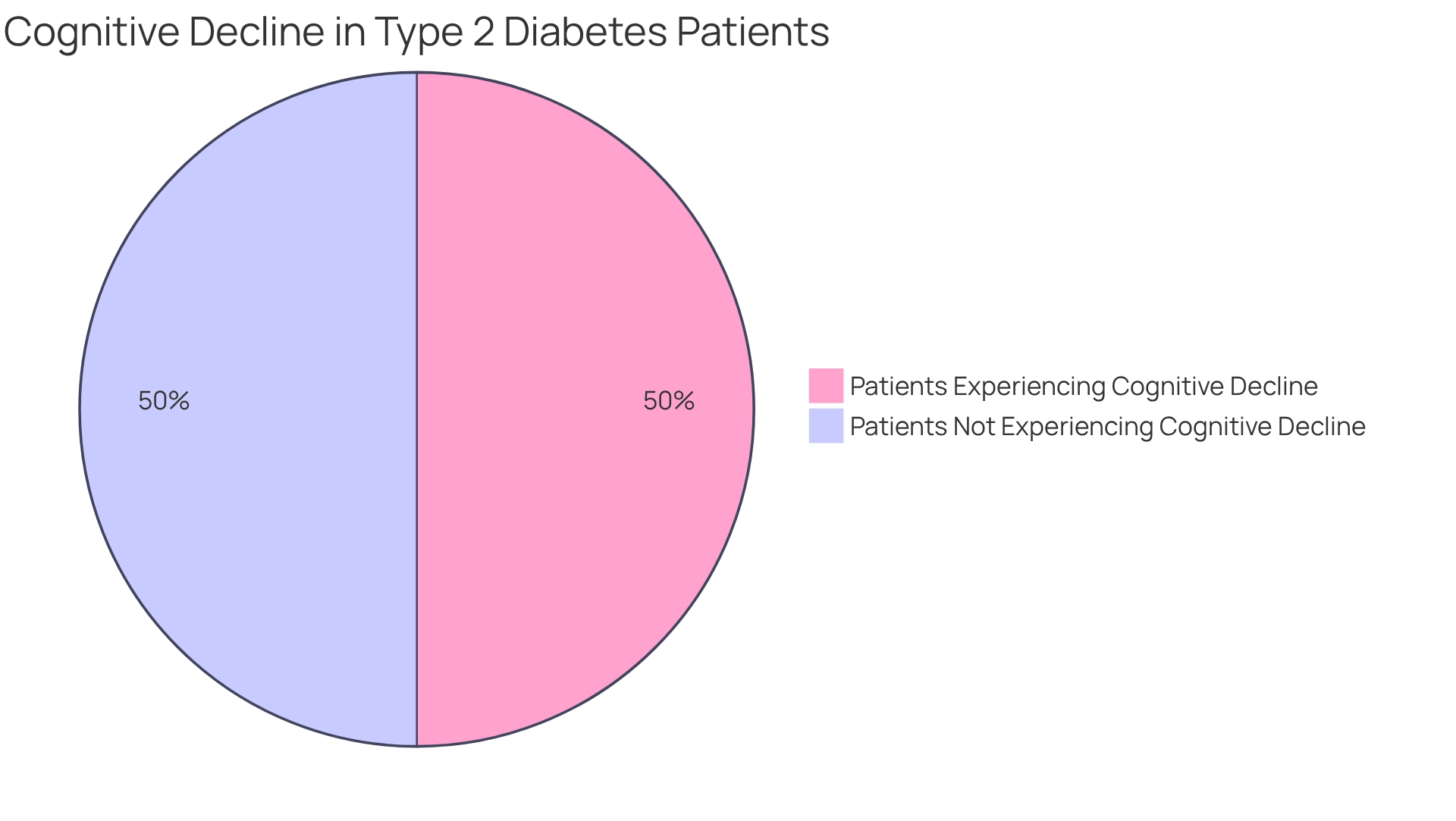Overview
Did you know that approximately 90% to 95% of diabetes patients have Type 2 Diabetes? This makes it the most prevalent form of the disease globally. Such a significant statistic underscores the importance of understanding this condition. The International Diabetes Federation and the Centers for Disease Control and Prevention provide valuable insights, showing that a large majority of diabetes cases are indeed Type 2.
It's understandable to feel overwhelmed by these numbers, but remember, you are not alone in this journey. The urgent need for effective management and prevention strategies is not just a statistic; it’s a call to action for all of us. Together, we can explore resources and support systems that can make a difference in managing Type 2 Diabetes. We are here to support you every step of the way.
Introduction
In a world where chronic diseases are increasingly prevalent, Type 2 Diabetes emerges as a significant health concern affecting millions of individuals globally. This condition, characterized by insulin resistance and a range of debilitating symptoms, poses challenges not only for those diagnosed but also for families, communities, and healthcare systems at large. It's understandable to feel overwhelmed by the alarming statistics—nearly 38 million Americans are living with Type 2 Diabetes, with many more unaware of their prediabetic status. The urgency for awareness and education has never been more critical.
As the prevalence of Type 2 Diabetes continues to rise, especially among younger populations, it becomes essential to understand the implications and connections of this condition. From the economic burden it places on healthcare systems to its association with cognitive decline, the multifaceted nature of Type 2 Diabetes calls for a proactive approach to management and prevention. You're not alone in this journey; together, we can empower individuals and foster healthier communities.
Let’s take a step forward in understanding this condition and exploring the resources available to support you and your loved ones. Remember, we are here to support you every step of the way.
Define Type 2 Diabetes: Key Characteristics and Symptoms
Condition 2 is a long-lasting ailment characterized by insulin resistance, where the body does not use insulin efficiently, leading to increased blood glucose levels. Common symptoms include:
- Increased thirst
- Frequent urination
- Fatigue
- Blurred vision
- Slow wound healing
Unlike the first form of the condition, which usually emerges during childhood, the second form is primarily identified in adults. However, it's concerning to note a rise in cases among younger groups, largely linked to increasing obesity levels. This raises the question of what percentage of diabetes patients have type 2, given that currently, around 37 million adults in the United States are living with a form of diabetes. This number underscores the necessity for awareness and early detection.
Furthermore, the Centers for Disease Control and Prevention (CDC) estimates that approximately 96 million American adults have prediabetes, with 80% unaware of their condition. This highlights the critical need for education on recognizing symptoms and seeking timely management, especially regarding what percentage of diabetes patients have type 2, which includes risk factors such as age, family history, and lifestyle choices along with the aforementioned symptoms. Specific health considerations for women and older adults are also important, as these demographics may face unique challenges in managing the condition.
Recent research emphasizes the importance of early intervention, as effective management can significantly improve quality of life and reduce the risk of complications. For instance, weight loss surgery has emerged as a viable treatment for obesity-related diabetes, with many patients achieving normal blood sugar levels post-surgery, although it carries a small short-term mortality risk. This treatment option is particularly relevant for individuals unable to control weight and blood sugar through other means.
Recognizing these symptoms is vital for individuals and healthcare professionals alike. As healthcare expert Lana Barhum notes, understanding the signs of Type 2 Diabetes can lead to earlier diagnosis and better management outcomes. Additionally, offering follow-up appointments or ongoing contact demonstrates a commitment to the patient's progress, which is crucial in managing this chronic condition. It's understandable to feel overwhelmed, but by fostering awareness and encouraging proactive health measures, we can collectively address the growing prevalence of this condition.
T2DSolutions seeks to be a valuable resource for newly diagnosed patients, offering educational materials and community support to assist individuals in managing their condition effectively. Remember, you're not alone in this journey; we are here to support you every step of the way.

Examine Prevalence: What Percentage of Diabetes Patients Have Type 2?
Recent data indicates that approximately 90% to 95% of all cases globally are related to what percentage of diabetes patients have type 2. The International Diabetes Federation (IDF) estimates that by 2025, around 11.1% of the worldwide adult population will be affected, and what percentage of diabetes patients have type 2 will comprise the majority of these cases. In the United States, the Centers for Disease Control and Prevention (CDC) estimates that about 38.4 million Americans, or 11.6% of the population, are impacted by diabetes, prompting the inquiry of what percentage of diabetes patients have type 2. This alarming prevalence underscores the critical need for effective management and prevention strategies.
In response to this escalating wellness crisis, T2DSolutions aims to serve as a comprehensive resource hub for individuals newly diagnosed with Type 2 Diabetes. By providing educational materials, community support, and practical management strategies, T2DSolutions is dedicated to empowering patients to take control of their health. You're not alone in this journey; support is available.
The global landscape of diabetes is evolving, with projections suggesting that the number of diabetes cases could soar from 529 million in 2024 to 1.3 billion by 2050. This increase is driven by rising obesity rates and complex socio-economic factors. A case study titled 'Challenges in Diabetes Prevention and Control' discusses the ongoing difficulties in preventing and managing the second form of blood sugar disorder, particularly in light of these rising obesity rates. Despite being largely preventable and potentially reversible, the prevalence of Type 2 Diabetes continues to rise, necessitating a deeper understanding of risk factors and disparities across populations.
In the Virgin Islands, for instance, the prevalence rate stands at an alarming 2082.7 per 100,000, underscoring the urgent need for targeted interventions. Furthermore, Morocco has experienced a remarkable rise in its condition burden by 451.5%, emphasizing the worldwide effect of this crisis. As the Bill & Melinda Gates Foundation highlights, understanding the disparities in risk factor profiles and the burden of this condition across various populations is crucial for creating effective strategies to tackle this escalating health crisis. The present statistics act as a call to action for individuals, families, and healthcare providers to prioritize management and prevention of the condition, and to connect with T2DSolutions for support and resources. We are here to support you every step of the way.

Analyze Implications: The Impact of Type 2 Diabetes Statistics on Healthcare
The widespread prevalence of Type 2 Diabetes highlights the need to understand what percentage of diabetes patients have type 2, which presents significant challenges for healthcare systems around the world. Millions are currently affected, leading to an increasing demand for essential diabetes management resources, including education, medical care, and support services, as well as inquiries about what percentage of diabetes patients have type 2.
The economic burden is staggering, with diabetes-related healthcare costs in the U.S. projected to reach approximately $412.9 billion by 2025. This financial strain underscores the urgent need for effective public initiatives aimed at prevention and early intervention, especially when considering what percentage of diabetes patients have type 2 diabetes, as the rising incidence among younger populations calls for a proactive approach that emphasizes lifestyle education and community support.
It's essential to recognize that addressing the social and economic environments in which individuals with this condition live is crucial for developing effective strategies to alleviate the financial burdens associated with the illness. Imagine if individuals with this condition could engage in the workforce like their counterparts without it—there would be 2 million more people aged 18 to 65 contributing to society, highlighting the broader societal impact of this illness.
By fostering community engagement and providing accessible resources, we can work together to mitigate long-term health complications and improve overall health outcomes for those affected. You're not alone in this journey. Additionally, advocacy efforts, such as AARP's push for changes in drug pricing, emphasize the importance of accessible medications in managing diabetes effectively. We are here to support you every step of the way.

Explore Related Conditions: The Connection Between Type 2 Diabetes and Type 3 Diabetes
This condition, often linked with Alzheimer's disease, involves insulin resistance in the brain. Recent studies reveal that what percentage of diabetes patients have type 2 diabetes face a significantly heightened risk of cognitive difficulties and neurodegenerative disorders. In fact, research suggests that nearly 50% of people with type 2 diabetes may experience some level of cognitive decline, prompting the inquiry of what percentage of diabetes patients have type 2. This highlights the critical need for effective blood sugar management.
As D Trico notes, 'The link between type 2 conditions and cognitive impairments emphasizes the urgent necessity for focused interventions to tackle these risks.' This connection underscores the importance of addressing Type 2 Diabetes not only for metabolic control but also as a potential strategy to reduce the risk of developing Type 3 Diabetes.
It's essential to understand that thorough education on managing blood sugar levels, along with lifestyle changes like dietary adjustments and regular physical activity, can be vital in tackling these interconnected health challenges. Moreover, the Lancet Commission emphasizes the need for high-quality data to inform policy decisions and improve management of this condition, particularly in low- and middle-income countries.
By fostering awareness and providing actionable resources, you can navigate your diabetes journey with greater confidence and enhance your overall cognitive health. Remember, you're not alone in this journey—we are here to support you every step of the way.

Conclusion
The rising prevalence of Type 2 Diabetes is a pressing health concern that affects millions, underscoring the need for greater awareness and education. With approximately 90% to 95% of all diabetes cases being Type 2, understanding its symptoms, risk factors, and potential complications is essential for early diagnosis and effective management. It's understandable to feel overwhelmed by the alarming statistics revealing that nearly 38 million Americans are living with this condition, with many more unaware of their prediabetic status. This highlights the critical importance of proactive health measures and the resources available for individuals and families.
The implications of Type 2 Diabetes extend beyond individual health, impacting healthcare systems and economies at large. The projected healthcare costs associated with diabetes are staggering, emphasizing the urgent need for public health initiatives focused on prevention and early intervention. Moreover, the connection between Type 2 Diabetes and cognitive decline, particularly the risk of developing Type 3 Diabetes, calls for comprehensive management strategies that address both metabolic and cognitive health.
Addressing the multifaceted nature of Type 2 Diabetes requires a collective effort. By fostering community engagement, providing educational resources, and advocating for accessible healthcare, it is possible to mitigate the long-term consequences of this chronic condition. Empowering individuals to take control of their health and encouraging proactive management can lead to improved outcomes not just for those diagnosed, but for society as a whole. You're not alone in this journey; the journey towards better health starts with awareness and action. It is crucial to embrace the available support and resources to navigate this challenge effectively.
Frequently Asked Questions
What is Condition 2, and how is it characterized?
Condition 2, also known as Type 2 Diabetes, is a long-lasting ailment characterized by insulin resistance, where the body does not use insulin efficiently, leading to increased blood glucose levels.
What are the common symptoms of Type 2 Diabetes?
Common symptoms of Type 2 Diabetes include increased thirst, frequent urination, fatigue, blurred vision, and slow wound healing.
Who is primarily affected by Type 2 Diabetes?
Type 2 Diabetes is primarily identified in adults, although there is a concerning rise in cases among younger individuals, largely linked to increasing obesity levels.
How many adults in the United States are living with diabetes?
Approximately 37 million adults in the United States are living with a form of diabetes.
What is the prevalence of prediabetes among American adults?
The CDC estimates that around 96 million American adults have prediabetes, with 80% of them being unaware of their condition.
What are the risk factors associated with Type 2 Diabetes?
Risk factors for Type 2 Diabetes include age, family history, lifestyle choices, and the symptoms associated with the condition.
Why is early intervention important for managing Type 2 Diabetes?
Early intervention is crucial because effective management can significantly improve quality of life and reduce the risk of complications.
What treatment option has emerged for obesity-related diabetes?
Weight loss surgery has emerged as a viable treatment option for obesity-related diabetes, with many patients achieving normal blood sugar levels post-surgery.
How can individuals and healthcare professionals recognize Type 2 Diabetes symptoms?
Recognizing the symptoms of Type 2 Diabetes is vital for both individuals and healthcare professionals, as it can lead to earlier diagnosis and better management outcomes.
What resources does T2DSolutions offer for newly diagnosed patients?
T2DSolutions offers educational materials and community support to assist newly diagnosed patients in managing their condition effectively.



